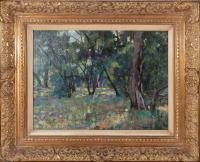Illustrated: "Western Australia, Paint, Pencil, Camera 1931", Page 21.
The highly regarded art critic for The West Australian newspaper, Charles
Hamilton, wrote of Pitt Morison in 1939:
“It is a pity this artist cannot devote more time to his studies, for
one is always tantalized by the thought of what he could really do if
he had the opportunity.”
...
Born in Melbourne in 1861, Pitt Morison studied part-time at the National
Gallery School and worked in various occupations until, in 1890, when he
seized the opportunity to study in Paris at the Académie Julian, despite
the objections of family and friends. While in France, he travelled around
the countryside painting with fellow Australian artist Emanuel Phillips
Fox, who was known for his paintings of dappled light. After his studies in
Paris, Morison travelled to Spain, where he further refined his skills by
copying the masterpieces at the Prado Museum.
In 1894, Morison arrived in Western Australia and worked in a photography
studio in Bunbury before securing a position with the Land and Surveys
Department. In 1906, he took on a role in the art department of the WA
Museum and Art Gallery, where he remained in different roles until his
retirement in 1942 at the age of 81.
Morison was a founding member of the WA Society of Artists and served as
its president in 1906. He was also a member of The Perth Society of Artists
and chaired the organization during the 1936-1937 term.
One of Morison’s most well-known works is
“The Foundation of Perth”
, commissioned by the Centenary Committee, of which he was a member. The
painting, which depicts Mrs. Dance felling the first tree, was meticulously
researched by Morison to ensure the accuracy of the clothing and the number
of observers present at the event. The completed work was presented to the
Art Gallery in 1929. Additionally, Morison designed the postage stamp
issued to commemorate Western Australia’s Centenary.
Always impeccably dressed, Pitt Morison was a distinguished and influential
figure in the Western Australia's arts scene. While he supported and
applauded emerging art trends, his own work was more aligned with his
classical training and a deep understanding of the old masters.
Despite his extensive study in Australia and France, Morison ultimately
chose a career in arts administration over that of a practicing artist. He
was a pragmatic individual with a family, and considered his
responsibilities over personal ambitions. He exhibited annually with the
societies of which he was a member, and early in his career, he even held
exhibitions in his own home.
The painting “The Sunlit Bush” reflects Morison's classical
training in composition, structure, and surface quality. The subject—a
forest floor illuminated by sunlight—captures the contrast between the
bright patches of sunlight and the more subdued shadows. The artist
masterfully conveys the atmosphere of a cool, densely wooded scene, with
the play of light acting as both a focal point and a guide for the eye.
Morison’s work is held in collections at the National Gallery in Canberra
and the Art Gallery of Western Australia. Portraits of him were painted by
his contemporaries Elise Blumann and John Brackenreg further cementing his
legacy.
Read more


